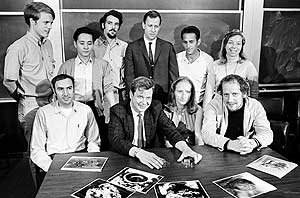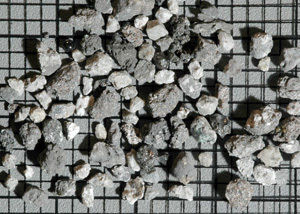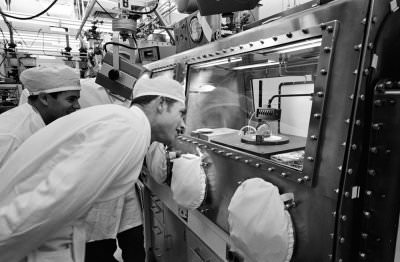[/caption]
Even though scientists have been able to study Moon rocks up close for almost 40 years, there are still many answers to be gleaned from the lunar samples collected by the Apollo astronauts. “We know even more now and can ask smarter questions as we research these samples,” says Randy Korotev from Washington University in St. Louis. “There are still some answers, we believe, in the Apollo 11 mission.” One possible clue the Moon rocks could provide is a better understanding of Earth’s history and when life actually began on our planet.
Korotev has been mainly interested in studying the impact history of the moon, how the moon’s surface has been affected by meteorite impacts and the nature of the early lunar crust.
“You can look at the moon and know that the moon has been hit a lot by very large meteorites,” he said. “We know this occurred some 3.9 billion years ago. We don’t know, however, the history of large meteorites hitting the Earth — we can’t see those impacts because they would have been erased by Earth’s active geology. We want to see if meteorite bombardment on the moon coincided with what was happening on Earth, and, in turn, with life starting on Earth.”
Recently, Korotev and his colleagues decided to begin taking a closer look at the Apollo samples to learn more about the Moon’s impact history. He says they still have much work to do with his samples, which have been chemically analyzed and are sealed in tubes and securely stored away for now.
Korotev expects the Apollo Moon rocks will provide scientific study for years to come, as our technology and understanding of the Moon improves. “We went to the moon and collected samples before we knew much about the moon,” he said. “We didn’t totally understand the big concept of what the moon was like until early 2000 as a result of missions that orbited the moon collecting mineralogical and compositional data.”
“Bringing samples back from the Moon wasn’t the point of the mission,” added Korotev. “It was really about politics. It took scientists like Bob Walker to bring these samples back — to show the value of them for research.”
Korotev credits Walker, also from Washington University and a handful of other scientists for the fact that there are even moon samples to study.
“Bob convinced them to build a receiving lab for the samples and advised them on the handling and storage of them. We didn’t go to the moon to collect rocks, so we scientists are really lucky that we have this collection.”
See Universe Today’s article on the history of the Lunar Receiving Lab.

Walker was recruited to serve on the scientific team that advised NASA on the handling and distribution of moon rocks and soil samples from the first Apollo missions. That team distributed Apollo 11 samples to some 150 laboratories worldwide, including Washington University, St. Louis (WUSTL).
Walker also briefed those early astronauts about what to expect on the rocky, dusty moon surface.
In an interview some months after the first moon samples arrived in WUSTL’s space sciences lab, Walker recalled the excitement of that momentous day in 1969: “We felt just like a bunch of kids who were suddenly given a brand new toy store … there was so much to do, we hardly knew where to begin.”
Ghislaine Crozaz, Ph.D., professor of earth and planetary sciences emerita in Arts & Sciences at Washington University and a member of Walker’s space sciences group that was one of those selected to study the first lunar samples, says the event is “as vivid in my mind as if it had happened yesterday.”

Crozaz says that the team studied the cosmic rays and radiation history of the lunar samples mainly using nuclear particle tracks, which were revealed by techniques invented by Walker.
“After we received the samples in early September, we worked like hell until the First Lunar Science Conference in early January 1970 in Houston, where we arrived with our Science paper after having worked ‘incommunicado’ for 4 months.”
In their study of the lunar materials, Walker’s laboratory led the way in deciphering their record of lunar, solar system and galactic evolution. Of special importance was the information they gave on the history of solar radiation and cosmic rays.
Crozaz says the lunar samples provided insights into the history of the solar system that couldn’t be achieved at the time by looking at meteorites found on Earth. The intense heat encountered during their passage through the atmosphere would have erased much of the record of radiation the meteorites carried.
Source: Washington University St. Louis


Thank’s Nancy for this news.
We have very little info about what is being done with these moon rocks? Have these rocks been cataloged as to there origin?
They are afterall pieces of metiorites since the moon does not has any vulcanic activity
to produce these rocks.
I have not seen any papers, of what has been
learned so far other than speculations and
assumptions? Some of these rocks must be older than the moon it self?
I’m looking forward at any info from you in this matter?
@ Bravehart, check out the ‘moon rock’ Wiki page and references within, here: http://en.wikipedia.org/wiki/Moon_rock . Quite a bit of science has been performed using lunar samples.